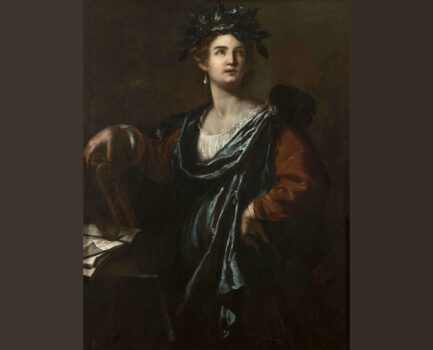Meaning of Clio, Muse of History Painting
When we think about the Baroque period, names like Caravaggio, Rubens, or Velázquez often dominate the conversation. Yet one of the most extraordinary painters of the 17th century was Artemisia Gentileschi, a woman whose career not only defied the constraints of her gender but also left behind works filled with psychological depth, symbolism, and an unflinching look at power and identity. Among her many striking canvases, Clio, Muse of History stands out as both a celebration of intellectual achievement and a statement of artistic self-definition.
This painting, completed around 1632, captures the essence of Clio, one of the nine muses of Greek mythology, traditionally associated with the writing of history and the chronicling of human achievement. But in Artemisia’s hands, Clio becomes more than just an allegorical figure, she becomes a meditation on history itself, on legacy, and on the act of writing one’s own story in a world where that story could easily be erased.
In this essay, we will explore the context in which Clio, Muse of History was painted, the symbolism woven into its imagery, the meaning of Clio’s presence in Artemisia’s oeuvre, and the painting’s place in the broader history of art. We will also consider the painting’s modern significance and where it can be found today.
Who Was Artemisia Gentileschi?
To understand Clio, Muse of History, we must first understand its painter. Artemisia Gentileschi (1593–c.1656) was the daughter of Orazio Gentileschi, a follower of Caravaggio. From an early age, Artemisia demonstrated prodigious talent, absorbing Caravaggio’s tenebrism and dramatic realism while also developing her own voice.
Her career was marked by both triumph and trauma. At age 17, she was abuse by Agostino Tassi, a painter associated with her father. The subsequent trial, one of the most infamous in art history, subjected Artemisia to public humiliation and physical torture intended to test her honesty. Rather than silencing her, this ordeal seemed to fuel her determination to succeed in a male-dominated field. Over the following decades, she gained international commissions, worked in Florence, Rome, Naples, and London, and built a reputation as one of the most important female artists of the Baroque period.
By the time she painted Clio, Artemisia was already celebrated across Europe. This painting belongs to a mature period in her career when she was not only technically accomplished but also deeply invested in allegory and the representation of female figures as embodiments of power, intellect, and authority.
The Subject: Clio, Muse of History
In Greek mythology, the nine muses were the daughters of Zeus and Mnemosyne (Memory). Each presided over a different aspect of the arts or sciences. Clio was the muse of history, often shown with a scroll, an open book, or a chest of scrolls symbolizing records of human events. She was believed to inspire historians and chroniclers, ensuring that the deeds of mortals would not be forgotten.
By choosing Clio as her subject, Artemisia was engaging with a powerful allegory. History was not just a neutral record; it was a narrative shaped by those who wrote it. In a world where women were often excluded from intellectual traditions and historical accounts, Artemisia’s depiction of Clio carried an implicit claim: women, too, are authors of history.
How Clio, Muse of History Was Painted
Artemisia created Clio around 1632, likely while she was in Naples, a vibrant cultural hub that attracted artists from across Europe. Painted in oil on canvas, the work demonstrates her mastery of Baroque techniques, deep chiaroscuro, a dramatic sense of presence, and rich, luminous colors that bring the figure to life.
The muse is portrayed as a monumental woman seated at an angle, gazing outward. She holds a trumpet in one hand and a book in the other. The trumpet symbolizes fame and the proclamation of historical deeds, while the book represents the recording of events, the act of history itself. Clio wears a crown of laurel leaves, a classical symbol of eternal glory and poetic inspiration.
Artemisia’s Clio is not a passive muse. She exudes authority and intellect, her body commanding the space of the canvas. Her drapery, rendered in brilliant folds of color, reinforces her monumental presence, while her thoughtful expression suggests both contemplation and determination.
What the Painting Represents
On the surface, Clio, Muse of History is an allegorical painting meant to personify the abstract concept of history. Yet for Artemisia, it was much more personal. The painting can be seen as a self-referential statement: Artemisia herself was writing her own place into history through her art.
The muse of history, in Artemisia’s hands, becomes a mirror of the painter’s own ambitions. Just as Clio records the deeds of others, Artemisia records her own struggles, victories, and identity through brushstrokes. To paint Clio is to declare: “I, Artemisia Gentileschi, am part of history, and I will not be forgotten.”
Some art historians even suggest that Clio bears resemblance to Artemisia’s own features, which she occasionally used in her allegorical figures. If so, this would reinforce the idea that the painting is simultaneously an allegory and a veiled self-portrait.
Symbolism in Clio, Muse of History
Every element of the painting carries symbolic weight. Let’s break down the key symbols:
The Trumpet
The trumpet signifies the announcement of glory and fame. In Clio’s hands, it represents the power of history to make deeds known to future generations. It is not simply about remembering, it is about proclaiming.The Book or Scroll
The book symbolizes the recording of events. It is a visual metaphor for memory made permanent, for history written down so that it cannot be erased. In Artemisia’s interpretation, this also reflects her personal act of writing herself into history through art.The Laurel Wreath
A crown of laurel leaves, associated with Apollo and the muses, symbolizes eternal fame, poetic inspiration, and victory. It also echoes Artemisia’s desire for lasting recognition.Clio’s Gaze
Her gaze is outward, directed not into the past but into the viewer’s world. This suggests a muse who is not locked in mythological time but present, active, and engaged with history as it unfolds.The Drapery and Color
Artemisia’s use of bold, luminous drapery links Clio to both classical grandeur and the theatricality of the Baroque. The rich colors, often blues, reds, and golds, reinforce her majesty and the timeless dignity of history.
Together, these symbols transform Clio into a meditation on power, permanence, and intellectual achievement.
What Is Happening in the Painting?
Unlike narrative paintings such as Artemisia’s Judith Slaying Holofernes, Clio, Muse of History does not depict an unfolding story. Instead, it captures a single moment of symbolic importance.
Clio sits, poised between thought and action. In one hand she holds the book of history, in the other, the trumpet of fame. Her stillness suggests contemplation, but the trumpet implies imminent proclamation. She is about to announce, to record, to shape the story of the world.
In this way, the painting is dynamic not because of physical motion but because of intellectual and symbolic tension. Clio embodies the very act of history in motion: the transition from memory to record, from silence to proclamation.
What Type of Art Is Clio, Muse of History?
Clio belongs to the tradition of Baroque allegorical painting. Baroque art, spanning the 17th century, was characterized by dramatic use of light and shadow, emotional intensity, and grandeur of scale. Within this tradition, allegorical works were common, artists personified abstract concepts like Justice, Fame, or History as figures from classical mythology.
Yet Artemisia’s Clio is not a generic allegory. Her interpretation blends Baroque theatricality with a feminist subtext that was rare for the period. By giving Clio such commanding presence, Artemisia elevates the muse beyond ornament. This is not history as decoration; this is history as a living, powerful force.
The Painting’s Location Today
Today, Clio, Muse of History is housed in the Museo di Capodimonte in Naples, Italy. The museum, located in a grand Bourbon palace, contains one of the most important collections of Italian painting, including works by Caravaggio, Titian, Raphael, and of course, Artemisia Gentileschi.
The presence of Clio in Naples is fitting, as the city was a key center of Artemisia’s career. She spent significant time there, securing commissions from noble patrons and producing some of her most ambitious works. Seeing Clio in Naples thus offers not just an encounter with the painting itself but with the city that helped shape Artemisia’s legacy.
Why Clio Matters
Clio, Muse of History matters for several reasons:
As a Baroque Masterpiece
The painting demonstrates Artemisia’s technical brilliance, the interplay of light and shadow, the richness of color, the monumental dignity of the figure.As a Feminist Statement
By painting the muse of history with such authority, Artemisia implicitly claims a place for herself, and for women, in the historical record.As an Allegory of Legacy
Clio is not just about recording the past; she is about shaping the future. The painting invites viewers to consider whose stories are preserved and whose are silenced.As Part of Artemisia’s Self-Definition
Through Clio, Artemisia asserts her role not just as an artist but as a figure of historical importance in her own right.
A Story Within the Painting
Imagine standing before Clio, Muse of History. The room is quiet, the light filtered through the high windows of the Capodimonte museum. The figure on the canvas looks back at you, calm yet commanding. She holds her trumpet and her book, ready to proclaim, ready to record.
It is as if Artemisia herself is speaking across the centuries: “I was here. My story matters. History is not complete without me.”
The painting becomes a dialogue between past and present, between the artist and the viewer, between history remembered and history forgotten.
Artemisia Gentileschi’s Clio, Muse of History is far more than an allegorical painting. It is a declaration of intellectual power, a reflection on legacy, and a self-portrait of the artist as historian of her own life. Painted in the vibrant context of 17th-century Naples, it fuses the grandeur of the Baroque with a deeply personal statement about art, history, and memory.
Today, as it hangs in the Museo di Capodimonte, Clio continues to remind us that history is not static. It is made by those who record it, by those who proclaim it, and by those who dare to paint themselves into its narrative. For Artemisia Gentileschi, to paint Clio was to seize her own place in history, and to ensure that we, centuries later, would still hear her voice.




